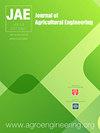Apple recognition and picking sequence planning for harvesting robot in the complex environment
IF 2.5
4区 农林科学
Q2 AGRICULTURAL ENGINEERING
引用次数: 0
Abstract
In order to improve the efficiency of robots picking apples in challenging orchard environments, a method for precisely detecting apples and planning the picking sequence is proposed. Firstly, the EfficientFormer network serves as the foundation for YOLOV5, which uses the EF-YOLOV5s network to locate apples in difficult situations. Meanwhile, the Soft Non-Maximum Suppression (NMS) algorithm is adopted to achieve accurate identification of overlapping apples. Secondly, the adjacently identified apples are automatically divided into different picking clusters by the improved density-based spatial clustering of applications with noise (DBSCAN). Finally, the order of apple harvest is determined to guide the robot to complete the rapid picking, according to the weight of the Gauss distance weight combined with the significance level. In the experiment, the average precision of this method is 98.84%, which is 4.3% higher than that of YOLOV5s. Meanwhile, the average picking success rate and picking time are 94.8% and 2.86 seconds, respectively. Compared with sequential and random planning, the picking success rate of the proposed method is increased by 6.8% and 13.1%, respectively. The research proves that this method can accurately detect apples in complex environments and improve picking efficiency, which can provide technical support for harvesting robots.复杂环境下收获机器人苹果识别与采摘顺序规划
为了提高机器人在复杂果园环境下采摘苹果的效率,提出了一种精确检测苹果并规划采摘顺序的方法。首先,高效前网络作为YOLOV5的基础,使用ef -YOLOV5网络定位困难情况下的苹果。同时,采用软非最大抑制(NMS)算法,实现对重叠苹果的准确识别。其次,采用改进的基于密度的带噪声应用空间聚类(DBSCAN)方法,将相邻识别的苹果自动划分为不同的采摘聚类;最后,根据高斯距离权值结合显著性水平的权重,确定苹果的收获顺序,引导机器人完成快速采摘。在实验中,该方法的平均精度为98.84%,比YOLOV5s的平均精度提高了4.3%。平均采摘成功率为94.8%,采摘时间为2.86秒。与顺序规划和随机规划相比,该方法的采摘成功率分别提高了6.8%和13.1%。研究证明,该方法可以在复杂环境下准确检测苹果,提高采摘效率,为收获机器人提供技术支持。
本文章由计算机程序翻译,如有差异,请以英文原文为准。
求助全文
约1分钟内获得全文
求助全文
来源期刊

Journal of Agricultural Engineering
AGRICULTURAL ENGINEERING-
CiteScore
2.30
自引率
5.60%
发文量
40
审稿时长
10 weeks
期刊介绍:
The Journal of Agricultural Engineering (JAE) is the official journal of the Italian Society of Agricultural Engineering supported by University of Bologna, Italy. The subject matter covers a complete and interdisciplinary range of research in engineering for agriculture and biosystems.
 求助内容:
求助内容: 应助结果提醒方式:
应助结果提醒方式:


